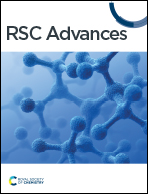Poly(butylene 2,5-furandicarboxylate) copolyester obtained using 1,6-hexanediamine with high glass transition temperature
Abstract
A series of furan-based poly(ester amide)s, namely poly(butylene 2,5-furanoate)-co-(hexamethylene furanamide) (PBAsF), were synthesized by partially substituting 1,4-butanediol (BDO) with linear hexamethylene diamine (HMDA). The introduction of amide bonding units enhances the intermolecular hydrogen bonding and intermolecular interaction forces, while the incorporation of flexible fragments results in a significant improvement in the thermal stability and mechanical properties of PBAsF. PBA20F exhibited an almost 50% increase in glass transition temperature, a mild improvement in tensile modulus of elasticity and tensile strength, and a tolerable decrease in elongation at break. Notably, the increased absorption in the UV wavelength range of PBAsF is enhanced due to the increase in amide bonding, which increases UV degradability. Additionally, the discovery of treatment methods with excellent performance in dye rejection is another important aspect.



 Please wait while we load your content...
Please wait while we load your content...